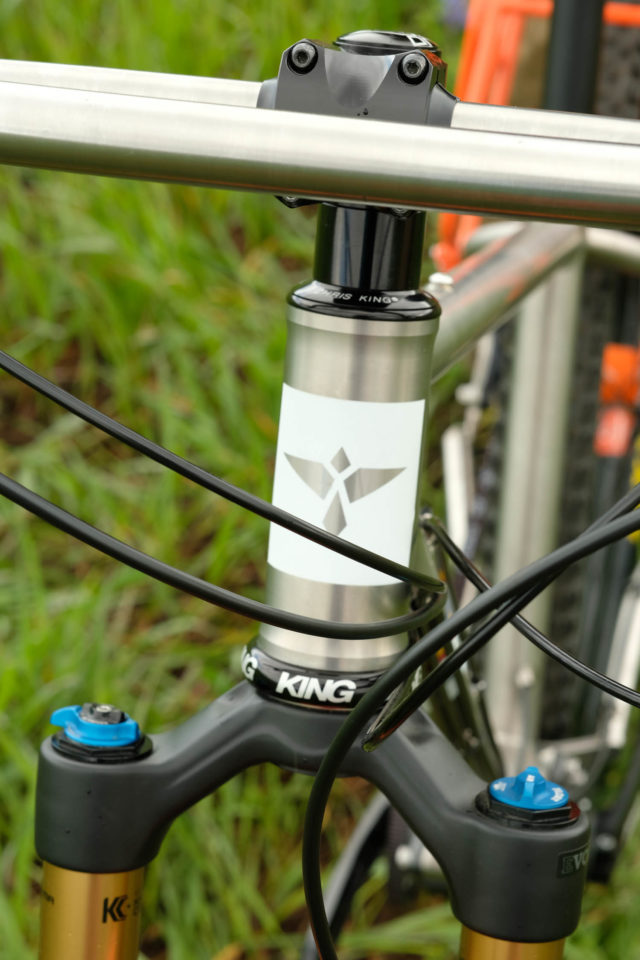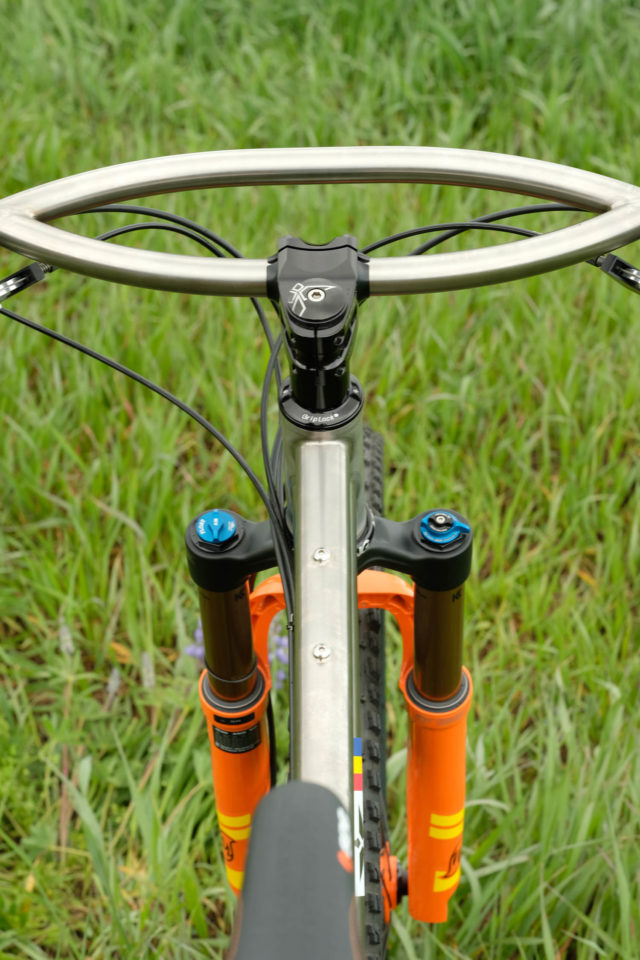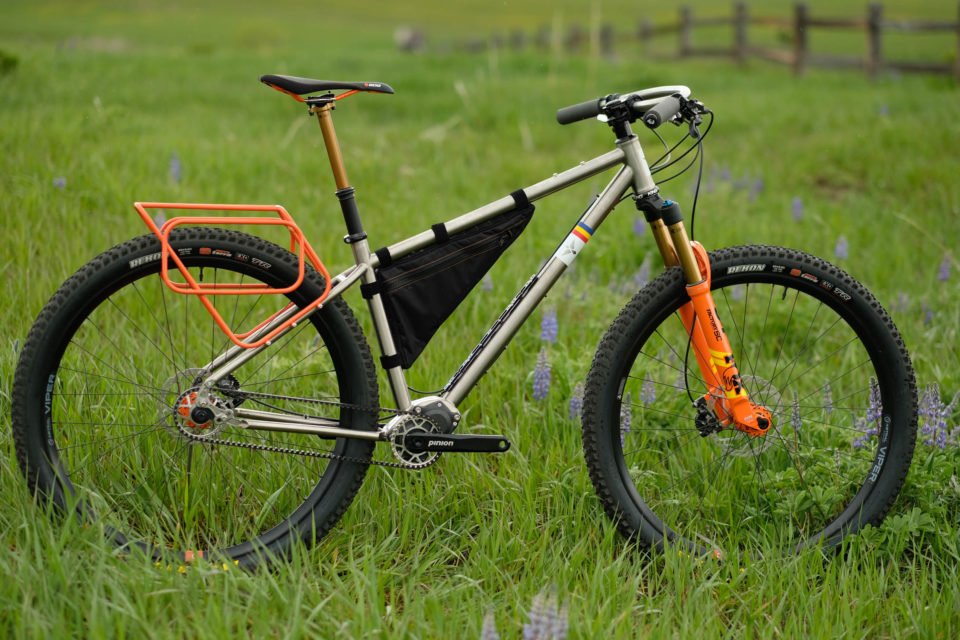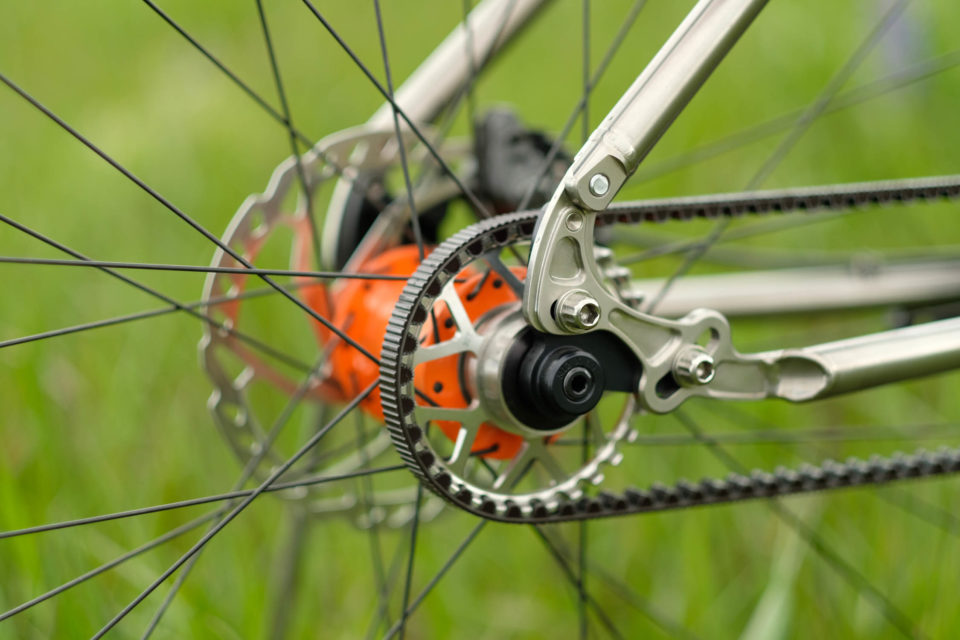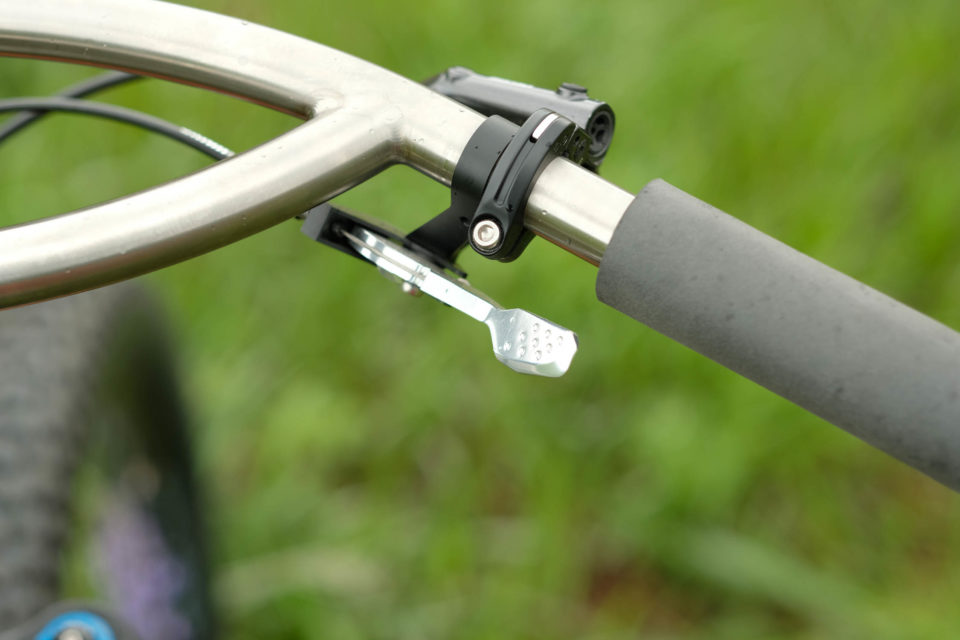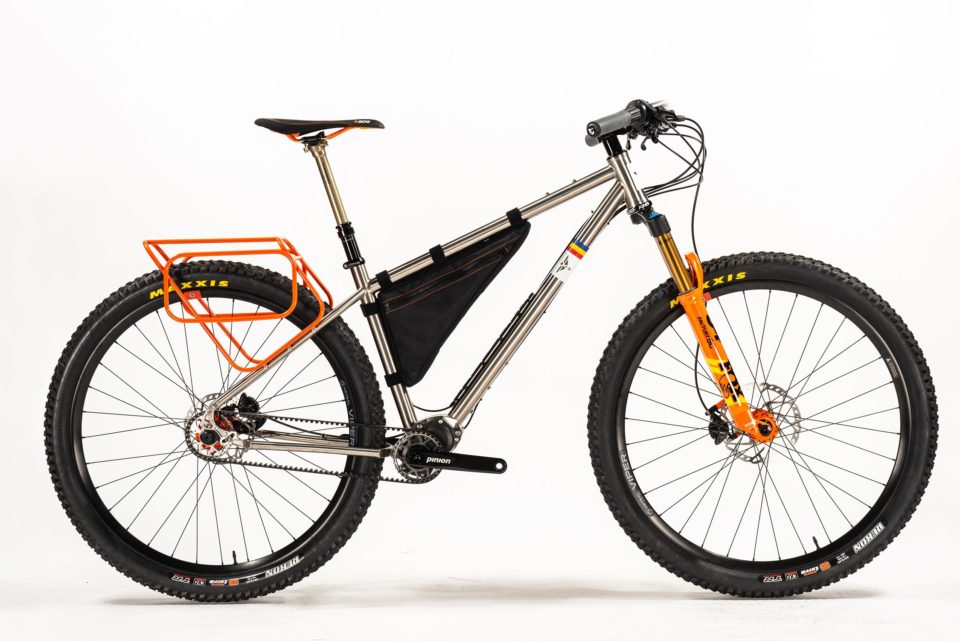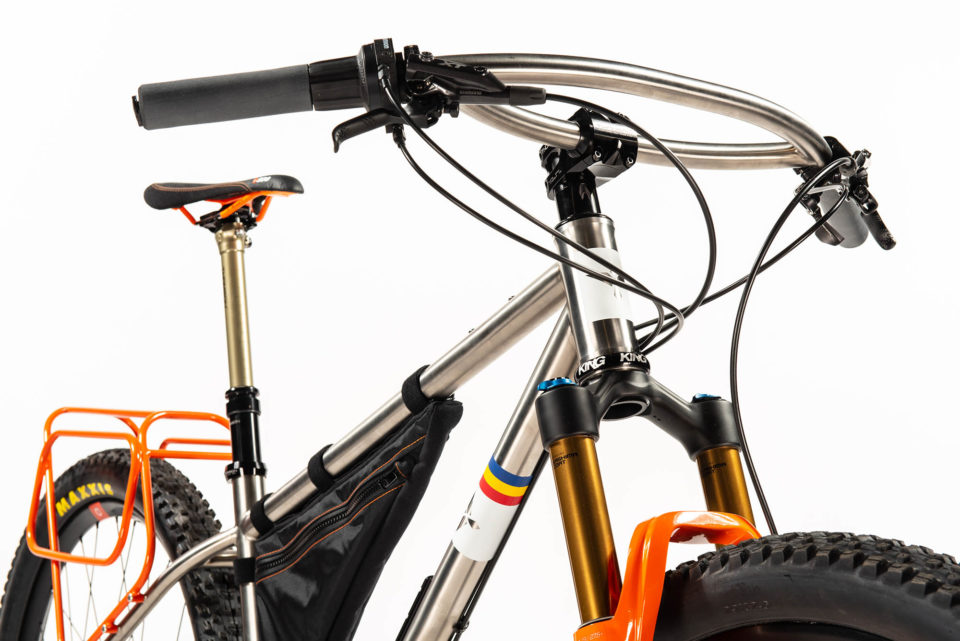Corvid Cycles’ Sojourner
Share This
A look at the Corvid Cycles Sojourner, a custom titanium dirt-touring rig, complete with a Gates/Pinion drivetrain, a unique titanium rear rack, US-made Astral/Onyx wheels, and an original titanium touring handlebar made for the Colorado high country. Here’s a gallery of the bike and a Q and A with builder Chad Corbin…
You first got a peek at the Sojourner in our NAHBS roundup of interesting bikepacking bikes from this year’s North American Handmade Bike Show. Boulder, CO based Corvid Cycles was a finalist in the 2019 NAHBS New Builder category with founder and builder Chad Corbin highlighting the Sojourner at the show. We had the chance to get some recent photos of the bike (by David Epperson of the MTB Hall of Fame) and ask Chad a few questions about it, his company name, and how he got started. Find more photos and a detailed Q and A below…

Tell me a little bit about how you got into bikes?
I’ve had a bike for as long as I can remember. My first real interest was in Freestyle back in the 80’s (!), although I was never any good. Sometime in middle school I was introduced to mountain biking and was hooked. I raced in high school and a little in college, with a short stint racing road and CX after moving to Colorado, but have been mostly on knobbies since. In high school I dreamt of one day designing mountain bikes. I pursued a mechanical engineering degree in college where I was redirected to biomechanics (prosthetics and artificial joints). After graduation I got wrapped-up in a programming career, then grad school, and never really thought that making bikes would be a viable path.
When did you start making bike frames and how did that come about?
I was racing CX in the mid 2000’s and discovered Vanilla in Portland. I thought Sacha’s bikes were absolutely gorgeous, and so commissioned a CX frame. I’d never really given much thought to custom handmade bikes before then, and I was fascinated by the idea. So, being curious and mechanically inclined, I researched how bikes were made and gave it a shot. Of course, my first frames were nothing like Vanillas, but I had fun learning how to build lugged and fillet brazed steel frames, and made a few for friends over a number of years. To be perfectly honest, I found the process to be exceedingly tedious never thinking that building bikes would ever be more than a hobby.
So how’d you start Corvid Cycles?
Fast forward more than a decade, through two advanced engineering degrees and a job as a research engineer at a national lab. My wife and I were living in Washington state, but weren’t happy. We decided to take some time off to reset and lived in a van for several months. As she went off to work on an organic farm, I decided to take the UBI (United Bicycle Institute) Ti framebuilding class—something I’d wanted to do for years. For several months thereafter, I kept returning to the thought of starting a business, so I bought a bunch of Ti tubing, a TIG welder, and practiced every day for the rest of the summer. Ultimately, we decided to move back to Colorado that fall and I sent out resumés hoping I could get an internship building bikes. I got lucky, was hired at DEAN Titanium, and started work shortly after our return. There I built a bunch of DEAN and Merlin frames, made a bunch of repairs, and learned a ton. I’m super thankful to have had that experience. John (founder and co-owner of the parent company) is a great guy and has helped launch a number of careers; it was an honor to have worked with him. Anyway, as my ambition and confidence grew, I decided to leave and start Corvid Cycles. That was about one year ago. As with most small businesses, you are initially supported by friends, then friends of friends, and eventually you start getting calls from strangers. It has been a fun ride so far and I’m still learning something every day.
Can you tell us about the name “Corvid” and where it came from?
There are several layers to this… Some time ago I looked up my family name, Corbin, to learn more about my family’s history. I learned that it meant raven and that the family crest featured one prominently. That was an interesting coincidence, because I always though ravens and their cousins in the Corvidae family were interesting birds for their intelligence and adaptability. When I started thinking about a name for my company, I listed a bunch of adjectives that I wanted to brand to represent. Intelligent and adaptable found their way to the top of the list: intelligent in the sense of being well designed, thought-out, and clever; adaptable reflecting a longer term plan to add adaptive cycles. Riding is the closest thing I can imagine to flight, so it seemed appropriate to select a bird—a raven—for the logo. Given all of that, Corvid seemed an obvious choice.

How did you come up with the Sojourner and its geometry?
I had three main objectives when designing the Sojourner. First, I wanted something reliable, so I chose a Pinion and Gates drivetrain paired with an Onyx hub. There is a bit of a weight penalty with the set-up, but I think the durability and low maintenance of the system is key for a bike like this. Second I wanted something that would be versatile and fun to ride both loaded and unloaded. I’ve been riding a really slack hardtail (65 HTA, 75 STA sagged, 27.5+) and have found it to be exceptionally capable climbing, descending, and everything in between. It is super stable, tracks predictably, and goes wherever I point it. I wanted those ride qualities for the Sojourner, so I settled on 67 HTA, 74 STA which gives me similar steering geometry with 29+ wheels. Oh, and it had to have a dropper and suspension fork to increase the grin factor. Finally, I wanted to showcase a few custom accessories, so I fabricated the rack and touring bars to complete the build. The bars are similar to Jones, but with less sweep, which I find to be very comfortable and easy to adapt to when transitioning from a riser bar.
The rack looks similar in nature to the Trek 1120’s rear rack, but it’s mounted differently. Can you tell us a little more about it?
I chose to build a rack for the Sojourner to help keep weight low and allow the use of a dropper without interfering with its operation. It is very much a prototype, inspired by the Trek 1120 and motorcycle racks common on enduro/adventure bikes. It is constructed primarily of titanium tubing, with solid bar in strategic locations. Attachment to the frame is by two sets of anywhere mounts, allowing the use other accessories when the rack is not needed. There are still some kinks to work out and I have some ideas for the next iteration.
What led you to build it around 29 x 2.6” tires?
I chose 29 x 2.6″ for this build because I think it represents a good balance of traction, volume (i.e. tire suspension), and weight. The frame will accommodate a 3″ tire with plenty of mud clearance. I tried to save some weight with the Step Cast fork which is limited to 2.6″ max tire width. Every frame I build is custom, so I could design the same bike for fatbike tires too.
Had you any experience with the Pinion prior to this bike? Do you think internal gearboxes are the future?
This is my first Pinion bike. I was initially concerned about getting the cuts for the shell correct, but with a little CAD work and trust in the numbers, it turned out to be pretty easy to build. I love the simplicity of the system. Obviously there is a lot going on inside the Pinion, but outwardly there is not much to do except bolt it on and run cables. This build also includes a pre-production version of the Cinq Shift:R Tour shifting system which is a great replacement for the stock twist shift. In terms of maintenance, there is very little required, which is one of its key selling points. The Pinion makes a lot of sense for touring and commuter bikes where a wide gear range, durability, and low maintenance are primary concerns. Until gearboxes can compete on weight with a traditional derailleur system, I think you will see their acceptance limited to these applications. I would love to see an electric assist version someday.
How’d you get into bikepacking?
I only recently got into bikepacking, and my experience so far has been limited to short local trips. I’ve done some backpacking and motorcycle touring/camping in the past, so the idea of covering longer distances than I could on foot, but without a moto, was appealing initially. Now I’m finding an attraction to the minimalist approach that bikepacking demands and the challenges this presents. I don’t think I will ever be a hard-core expedition bikepacker, but I do see some mellow week long trips in the near future. I’ve been wanting to do the Durango to Moab ride for years.

What’s been your favorite multi-day trip, so far?
Rollins Pass in the fall. Great views of the snow-capped Indian Peaks, relatively low traffic at that time of year, and the aspen leaves are brilliant if you time it right. It’s a short and easy trip on a combination of pavement, single track, and jeep roads that I can do it from my front door. Short trips are key for me right now since I am putting so much of my time and energy into building a sustainable business.
Can you give us an idea of what a Sojourner would cost?
A Sojourner frame designed for a derailleur drivetrain runs around $2600; the Pinion version goes for $2900 . Complete cost varies greatly depending on components and accessories. This particular build retails for $6100 with the bar and rack adding $325 and $375, respectively. Oh, and I should mention that every Sojourner comes with a titanium pack trowel made from tubing scraps.
What’s your lead time, and what can someone expect if they order one from you?
My current wait list is around 2 months. Building a custom bike is a collaboration, so customers can expect a lot of communication during the design process. I start with an in-depth conversation with the customer to discuss goals for the build, intended use, features, component preferences and budget. More often than not, one or more of those aspects will be in conflict with another so it is critical to understand which ones will drive the design. I have my customers take measurements of themselves and of their current bikes, or have them work with a professional fitter in order to determine frame dimensions. Next, I draw-up a preliminary frame design, component spec and cost estimate, and once approved, I take a deposit, which puts the build on my build calendar. I’ll notify the customer as I start their build, keeping them up-to-date on progress until their build is complete 1-2 weeks later.
Interested in learning more about Corvid Cycles? Check out Chad’s website at CorvidCycles.com and follow him on Instagram @corvidcycles.
Please keep the conversation civil, constructive, and inclusive, or your comment will be removed.













